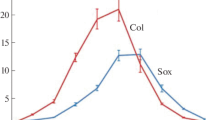Abstract
The electrostatic interaction between positively charged copper nanoparticles aggregates (ζ = +15.9 ± 8.63 mV) and negatively charged surface of E. coli K12 TG1 cells (ζ = -50.0 ± 9.35 mV) has been established. The time-dependent decline of bacterial cells zeta potential and the coupled inhibition of constitutive bioluminescence level are the results of this interaction. The development of oxidative stress, probably defined by the electron transfer from the cytoplasmic membrane respiratory chains through membrane-integrated copper nanoparticle to the molecular oxygen, is shown as luminescence induction in superoxide- and peroxide-inducible E. coli K-12 MG1655 pSoxS::lux and pKatG::lux reporter strains. The final result of this process, which is responsible for the development of the bactericidal effect of copper nanoparticles, is DNA damage by active oxygen species detected by SOS-inducible E. coli pRecA::lux luminescent strain.
Similar content being viewed by others
References
M. A. Timofeev, M. V. Protopopova, and A. V. Koles- nichenko, “Nanomaterials toxicity: 15-year research,” Ross. Nanotekh. 3(3–4), 54–61 (2008).
I. Blinova, A. Ivask, M. Heinlaan, M. Mortimer, and A. Kahru, “Ecotoxicity of nanoparticles of CuO and ZnO in natural water,” Environ. Pollut. 158(1), 41–47 (2010).
N. Cioffi, L. Torsi, N. Ditaranto, G. Tantillo, L. Ghibelli, L. Sabbatini, T. Bleve-Zacheo, M. D’Alessio, P. G. Zambonin, and E. Traversa, “Copper nanoparticle / polymer composites with antifungal and bacteriostatic properties,” Chem. Mater. 17(21), 5255–5262 (2005).
A. A. Rakhmetova, T. P. Alekseeva, O. A. Bogoslovskaya, I. O. Leipunskii, I. P. Ol’khovskaya, A. N. Zhigach, and N. N. Glushchenko, “Wound-healing properties of copper nanoparticles as a function of physicochemical parameters,” Nanotechnologies in Russia 5(3–4), 271–276 (2010).
M. Heinlaan, A. Ivask, I. Blinova, H. C. Dubourguier, and A. Kahru, “Toxicity of nanosized and bulk ZnO, CuO and TiO2 to bacteria Vibrio fischeri and crustaceans Daphnia magna and Thamnocephalus platyurus,” Chemosphere 71(7), 1308–1316 (2008).
P. Gajjar, B. Pettee, D. W. Britt, W. Huang, W. P. Johnson, and A. J. Anderson, “Antimicrobial activities of commercial nanoparticles against an environmental soil microbe, Pseudomonas putida KT2440,” J. Biol. Eng. 3, 9 (2009). doi:10.1186/1754-1611-3-9.
J. P. Ruparelia, A. K. Chatterjee, S. P. Duttagupta, and S. Mukherji, “Strain specificity in antimicrobial activity of silver and copper nanoparticles,” Acta Biomater. 4(3), 707–716 (2008).
I. V. Babushkina, V. B. Borodulin, G. V. Korshunov, and D. M. Puchin’yan, “Comparative study of antibacterial action of iron and copper nanoparticles on clinical Staphylococcus aureus strains,” Saratovsk. Nauch.-Med. Zh. 6(1), 11–14 (2010).
F. Rispoli, A. Angelov, D. Badia, A. Kumar, S. Seal, and V. Shah, “Understanding the toxicity of aggregated zero valent copper nanoparticles against Escherichia coli,” J. Hazard. Mater. 80(1–3), 212–216 (2010).
D. G. Deryabin, Bacterial Bioluminescence: Fundamental and Applied Aspects (Nauka, Moscow, 2009) [in Russian].
M. Mortimer, K. Kasemets, M. Heinlaan, I. Kurvet, and A. Kahru, “High throughput kinetic Vibrio fischeri bioluminescence inhibition assay for study of toxic effects of nanoparticles,” Toxicol. in vitro, No. 5, 1412–1417 (2008).
G. B. Zavilgelsky, V. Yu. Kotova, and I. V. Manukhov, “Titanium dioxide (TiO2) nanoparticles induce bacterial stress response detectable by the specific lux biosensors,” Nanotechnologies in Russia 6(5–6), 401–406 (2011).
Methodological Recommendations no. 1.2.2634-10: Microbiological and Molecular-Genetic Estimation of Nanomaterials Effect onto Microbiocenosis (Federal Centre for Hygiene and Epidemiological in Moscow, Moscow, 2010) [in Russian].
M. L. Kuskov, I. O. Leipunskii, N. I. Stoenko, V. B. Storozhev, and A. N. Zhigach, “The way to produce superfine metals powders, alloys, metals jointing by means of Gene-Muller method: history, modern state, trends,” Ross. Nanotekhnol. 7(3-4), 28–37 (2012).
I.P. Arsenteva, T. A. Bajtukalov, N. N. Glushchenko, E. L. Dzidziguri, E. S. Zotova, E. N. Sidorova, O. A. Bogoslovskaya, “Certification of nanoparticles of copper and magnesium and application of them in medicine,” Materialoved., No. 4, 54–57 (2007).
V. S. Danilov, A. P. Zarubina, G. E. Eroshnikov, L. N. Soloveva, F. V. Kartashov, and G. B. Zavilgelsky, “The bioluminescent sensor systems with lux-operons from various species of luminescent bacteria,” Vestn. Mosk. Univ. Ser. 16. Biol., No. 3, 20–24 (2002).
D. G. Deryabin, E. S. Aleshina, and L. V. Efremova, “Application of the inhibition of bacterial bioluminescence test for assessment of toxicity of carbon-based nanomaterials,” Mikrobiol. 81(4), 492–497 (2012).
Z. Chen, H. Meng, G. Xing, C. Chen, Y. Zhao, G. Jia, T. Wang, H. Yuan, C. Ye, F. Zhao, Z. Chai, C. Zhu, X. Fang, B. Ma, and L. Wan, “Acute toxicological effects of copper nanoparticles in vivo,” Toxicol. Lett. 163(2), 109–120 (2006).
M. Kosmulski, “pH-dependent surface charging and points of zero charge. IV. Update and new approach,” J. Colloid Interface Sci. 337, 439–448 (2009).
A. Kumar, A. K. Pandey, S. S. Singh, R. Shanker, and A. Dhawan, “Engineered ZnO and TiO2 nanoparticles induce oxidative stress and DNA damage leading to reduced viability of Escherichia coli,” Free Radical Biol. Med. 51(10), 1872–1881 (2011).
D. G. Deryabin, E. S. Aleshina, and A. S. Tlyagulova, “Acute toxicity of carbon-based nanomaterials to Escherichia coli is partially dependent on the presence of process impurities,” Nanotechnologies in Russia 6(7–8), 528–534 (2011).
Author information
Authors and Affiliations
Corresponding author
Additional information
Original Russian Text © D.G. Deryabin, E.S. Aleshina, A.S. Vasilchenko, T.D. Deryabina, L.V. Efremova, I.F. Karimov, L.B. Korolevskaya, 2013, published in Rossiiskie Nanotekhnologii, 2013, Vol. 8, Nos. 5–6.
Rights and permissions
About this article
Cite this article
Deryabin, D.G., Aleshina, E.S., Vasilchenko, A.S. et al. Investigation of copper nanoparticles antibacterial mechanisms tested by luminescent Escherichia coli strains. Nanotechnol Russia 8, 402–408 (2013). https://doi.org/10.1134/S1995078013030063
Received:
Accepted:
Published:
Issue Date:
DOI: https://doi.org/10.1134/S1995078013030063




